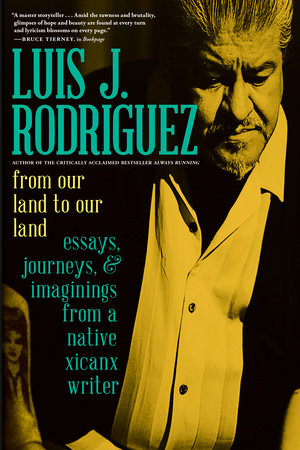Luis J. Rodriguez
What stories, thinking, and organizational forms are needed for the chaotic political times we are in? There are thousands of ideas flaunted everywhere, especially on the internet, with or without any basis in truth or facts, ideas from the most reactionary to the most visionary. Which of these will take hold among the most exploited and oppressed of this country—and the world—as they move to break the chains on labor, creativity, minds, and hearts?
We are in “pregnant” times—something vital, encompassing, and whole is trying to be born, even as the old capitalist relations and structures are poised to strangle the “baby” before its birth. We are at the end of capitalist development, expressed as crisis upon crisis, and simultaneously in the beginning of what will arise to complete the revolutionary aims of the mass response.
Last year, 2019, was one of the most heated with protests and uprisings, mostly due to the economic squeeze from global finance and transnational corporations. Mass demonstrations in Lebanon, Iraq, Chile, Ecuador, Bolivia, Brazil, and Puerto Rico decried growing fascism and corruption. The reaction, with an array of violence and false narratives, hit hard against anything that got in their way.
Capitalism is being stretched to its limits, the limits of imposed scarcity. There are visions of abundance based on four key pillars: end of poverty, a clean & green planet, peace at home and abroad, and justice for all—with full participatory and incorruptible governance undergirding everything.
This is true of the United States, with the world’s most powerful military, although weak among developed countries when it comes to poverty, health, climate, and violence. Yes, capitalism has created the most wealth of any system in over 500 years or so, but also the widest gap between the wealthiest and the rest of us. The 1 percent versus the 99 percent.
I decided to contribute to the intense conversations (or rants, as the case may be) on which way to go from here? Quite a monumental challenge. But choosing not to was not an option.
For years, I’ve written essays and opinion pieces for publications as varied as the New York Times, Chicago Tribune, Los Angeles Times, US News & World Report, Grand Street, The Nation, Philadelphia Inquirer Magazine, The Progressive, Christian Science Monitor, and the Huffington Post, among others. But, despite having 15 books in poetry, fiction, nonfiction, and children’s literature, I’ve not put together a collection of essays—until now.
Seven Stories Press released From Our Land to Our Land: Essays, Journeys & Imaginings of a Native Xicanx Writer at the end of January 2020. Although I’ve drawn from past writings in this book, each essay has been rewritten, updated, and follows my thoughts and interests to the present.
Here I explore the system’s drive to uproot people from traditional terrains, tongues, and customs. Temporariness pervades everything. We’ve lost our grounding on a micro and macro scale. Capitalism re-makes people from all corners into exploitable workers—whether in sweat shops or as minions in other industries—or as war fodder.
Presently, thousands from El Salvador, Guatemala, Honduras, and parts of Mexico are stranded on the US-Mexico border. They came as asylum seekers—which is legal under international and US law. Yet the Trump Administration has treated them as “illegals,” inhumanely crowding them into cages and camps, even though the government’s actions and policies are what’s breaking the law. Poverty, violence, and corruptions in their own countries have pushed them north, from their homes and families. Many are children—around 6,000 have been removed from their families, lost in the labyrinth of detention, courts, and deportations, subject to human trafficking and intensifying cruelty.
Not to be overlooked, these refugees are mostly indigenous to these lands. They include Mayans from Guatemala and southern Mexico; Pibil and Lenca from El Salvador and Honduras; Mixteco, Zapoteco, Nahua, and more from other parts of Mexico. And, of course, the indigenous who have no tribes, who have been “Hispanicized” from 500 years of conquest, colonialism, and invasion.
These people, who have ties to these lands as long as anyone’s, are now the “foreigners,” “strangers,” and “aliens.”
Capitalism has turned everything on its head.
Informed by 40 years of study of revolutionary dialectical and historical materialism and political economy, this book also drew on ancestral knowledge from native cosmologies that have managed, against all odds, to exist among Native Americans as well as Native Mexicans and Central Americans. Not as archaic and quaint concepts but as mythic imaginations to guide us into a future free of want, despair, loss.
The essays also address my forty years working in US prisons, jails, and juvenile lockups—in 17 states—but also in Mexico, Central America, South America, and Europe. How I’ve taught creative writing, read poetry, held lectures or healing circles behind bars and what I’ve learned. In particular, why I’m an abolitionist—ending mass incarceration altogether, replaced with enriched and proven transformative justice practices.
There is also an essay about the “other” Los Angeles—from where I lived and worked in Watts to East Los Angeles to the Harbor to the Northeast San Fernando Valley, the largest manufacturing center in the country. And, like most industrial US cities, this area suffered major loss of industry from the 1980s till today. I have an essay on the ongoing “race wars,” how all these are made-up conflicts used to divide the common interests of the American working class. There’s a piece on my role as Los Angeles Poet Laureate from 2014 to 2016, drawing on the natural poetry among the people and taking poetry across the 600 square miles of the city. I also summarize my unsuccessful but impactful run for California governor. And I’ve included personal pieces on the influence of Chicanos and lowrider culture on Japanese youth; what it means to be a “man” at the end of patriarchy; and my connection to the most conscious elements of Hip Hop.
The thread running through this book is a vision for a new world, one within our collective grasp. How we need the adequate teachings, strategies, and organizing to move imaginations, then people, to realize the possibilities latent in our technology, creativity, work, and unity.
Now more than ever.


